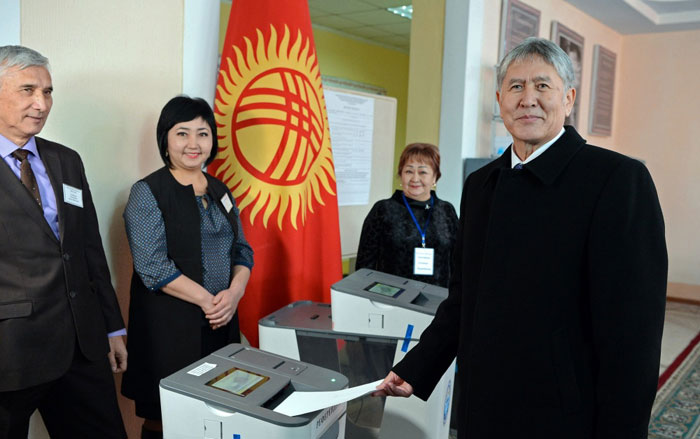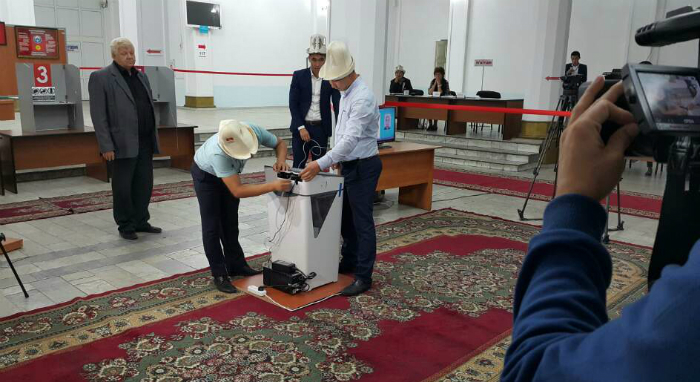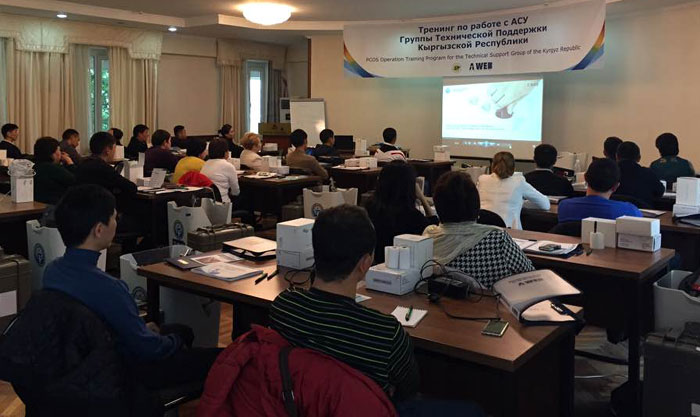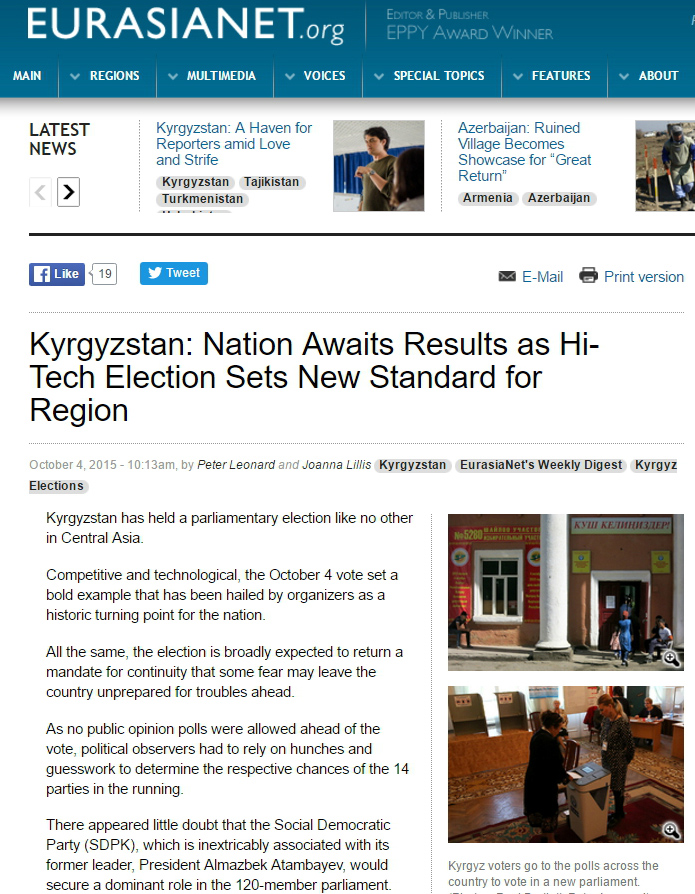-
 Korea.net's 24-hour YouTube channel
Korea.net's 24-hour YouTube channel- NEWS FOCUS
- ABOUT KOREA
- EVENTS
- RESOURCES
- GOVERNMENT
- ABOUT US
So said President Almazbek Atambayev of Kyrgyzstan on Oct. 5, 2015, a day after the parliamentary election.
President Atambayev has been enthusiastically carrying out the introduction of an automated electoral system with the goal of achieving political stability and democracy.
The Kyrgyzstani leader said, “As citizens trust the election results, we didn't have any protest as we did before. So this is one of the happiest days of my life.”
“This election realized one of my biggest dreams,” he said.

Kyrgyzstani President Almazbek Atambayev (right) poses for a photo as he inserts his ballot into a precinct count optical scan (PCOS) machine, a device that's crucial for automated electoral systems, during a referendum on Dec. 11, 2016. This system was test-operated in local elections in May 2015 and in the parliamentary election in October 2015.
The introduction of an automated electoral system was part of the National Sustainable Development Strategy 2013-2017, a form of overseas development assistance (ODA) between Korea and Kyrgyzstan. This project was jointly conducted by Korea’s National Election Commission, the Association of World Election Bodies (A-WEB) and the Korea International Cooperation Agency since April 2014. It was originally initiated in October 2013 after the head of the Central Election Commission of Kyrgyzstan (CEC), Tuigunaaly Abdraimov, saw Korea’s automated election system first-hand during an opening ceremony for the A-WEB. The head of the CEC returned home and asked the president to support the establishment of such a system in their home country. A month later, in November 2013, the Korean and Kyrgyzstani leaders held talks and this was one of the issues on the summit table. After a series of high-level meetings between the two countries, it became a concrete project.
After achieving independence from the USSR in 1991, Kyrgyzstan adopted democracy and held several rounds of elections. The country, however, was unable to cut the chain of corruption, such as fraudulent elections and suppression of the press. Kyrgyzstanis did not trust their political system. They even brought about revolutions twice, in 2005 and 2010. Due to the political instability, they were unable to stop corruption during elections, such as voting twice or manipulating the results, which kept credibility very low. In some places, there were more ballots than voters, or vice versa. Some people even voted on behalf of other people. All the results were counted manually, too, which took two or three days, or even up to seven days.

Kyrgyzstani officials collect ballots after the votes close. An automated electoral system was used during parliamentary elections in Kyrgyzstan in October 2015.
To establish an automated electoral system in Kyrgyzstan, Korea conducted a thorough analysis and consulted the target government in advance. It supported and shared its know-how in establishing a data center, backed by Korea’s information and communications technology (ICT). Korea also developed an election information system, provided the precinct count optical scan (PCOS) devices, managed an educational and training program and sent experts to Kyrgyzstan for some hands-on guidance.
The automated electoral system was test-operated in local elections in May 2015 with 100 PCOS machines. It proved to be accurate in test operations that took place at 49 voting locations in five provinces, despite some difficulties, including a month-long preparation, an unstable network both on- and offline, and bad weather.
Five months later, PCOS devices were used at 2,338 voting locations in a parliamentary election in Kyrgyzstan.
After the polls closed, the preliminary results were released within two hours after the start of counting, thanks to a system that enabled the counting of 95 percent of the ballots, earning faith and trust in its results.

Kyrgyzstani citizens and officials learn how to use an automated voting system. In order to build the automated electoral system in Kyrgyzstan, Korea provided educational and training programs for local election officials.
The PCOS machines use a light to automatically decode the ballots. This is the key technology used in automated election systems. Unlike existing, manual systems, where a human divides ballots one by one that had been cast into a ballot box, this new system can automatically recognize the ink on the ballot when it is cast using a PCOS device. This helps to prevent various forms of corruption and can ensure the accuracy of the election results. After the final counting, the election results were directly sent to the CEC via the internet.
International media outlets have highly praised Kyrgyzstan’s newly-introduced automated electoral system. The U.K.-based Financial Times said on Oct. 10, 2015, that, “It will set a good example in Central Asia.” Earlier, on Oct. 5, Eurasianet, a U.S.-based publication that focuses mainly on Europe and Asia, said, “Competitive and technological, the Oct. 4 vote set a bold example that has been hailed by organizers as a historic turning point for the nation."
The system has also been used in the recent referendum in Kyrgyzstan in December 2016. It will also be used in the upcoming presidential election there in November this year.

International media outlets praise the newly automated electoral system first introduced in 2015. Eurasianet dubbed the election as a ‘historic turning point.’
A total of 613 observers from 69 countries witnessed Kyrgyzstan’s parliamentary election, backed by the introduction of the new system. After witnessing the success in Kyrgyzstan, about 11 countries have taken an interest in the automated electoral system. These countries include its neighbors in Central Asia, Uzbekistan and Kazakhstan, as well as other countries, including Ecuador and Ghana.
Korea will work further with El Salvador, Congo, Fiji, Uzbekistan, and Ecuador in order to support the automation of electoral systems within the year.
By Yoon Sojung
Korea.net Staff Writer
Photos: A-WEB
arete@korea.kr













